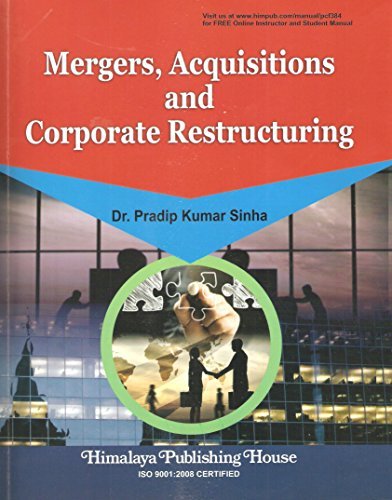Mergers, Acquisitions and Corporate Restructuring
no information available
We live and work in a multi-polar world where sources of supply and demand are constantly evolving and shifting around the world. Organizing and growing a global business has never been so attainable, particularly in emerging economies; at the same time, it has never been so complex. The same interconnections between countries, companies and people that bring an abundance of opportunities, also bring with them new and multifaceted risks. In this competitive environment, M&A has grown to become a popular aveneue to achieve rapid reach and scale. The new dynamics of M&A by Indian companies put a premium on supply chain intefration as a key contributor to successful M&A. In this backdrop, Restructuring, rehabilitating, re-engineering, revising and re-incarnating-all for furvival and growth. In Chapter 1, various reasons, occasions and ambitions for restructuring have been discussed. Chapter 2, begins with how restructuring can be done through amalgamation, Mergers and Acquisitions and M&A s role in transformation of economy - United States and India. The chapter also covers stages of the Merger and Acquisition (M&A) Process both from buyers and sellers point of view. Chapter 3 presents review of the planning process and the role of diversification and mergers in strategic planning. Chapter 4 goes through motivations of Buying or Selling the Business including hostile takeovers. Chapter 5 discusses what is due diligence about and the importance of cultural due diligence i.e. a look at corporate cultures and attempts to ascertain an orgnizational fit between the two merging companies. Chapter 6 explains synergy value that is, various technical and financial aspects of the M&A transcations that can present opportunities to make one plus one equal to three. It also presents ways in which transactions can be structured to capitalize on the synergistic opportunities. It also covers the estimated economic gains and costs from mergers and the area of Contract possibilities - a Generalized Model, The share exchange ratio, the Bargain Zone and the Valuation of the Merging Corporations. Chapter 7 covers Deal types and Financing of Mergers and Acquisitions. Chapter 8 deals with Accounting for Mergers and Acquisitions. Chapter 9 explains in detail Tax Effective Structuring of Amalgamation, Merger or De-merger of Companies including Cross Border acquisitions. Chapter 10 deals with Corporate Finance Framework i.e. restructuring and ownership changes involved in merger and tender offer activitiy often affect and are influenced by the financial structures of firms. To separate the effects of purely financial policy changes from other forms of restructuring, the chapter seeks to provide some perspectives on corporate financial policies and decisions. Various methods of valuing a business enterprise, its assets are covered in Chapter 11. Chapter 12 explains that M&A just like capital expenditure decisions involve huge capital outlay and difficult to reverse, hence needs to be handled with caution. The chapter also covers four primary issues in strategic considerations of Mergers & Acquisitions i.e. M&A activity should come within the framework of Strategic Planning, Identification of synergies, Valuation and Integration. The chapter also covers the causes of risk in M&A and its preventive measures. Chapter 13 covers Employee Stock Option Plan (ESOP). Chapter 14 deals with Corporate Control Mechanism and Take Over Defenses. Chapter 15 considers Final Stages of Mergers & Acquisitions i.e. stages to make the buy/sell decision and also methods of dealing with a decision to back out of the transcation. It also explains the areas of consideration when developing an integration strategy and specific steps of successful post acquisition integration. Chapter 16 deals with Regulatory Framework of Mergers and Acquisitions i.e. procedure for Merger and Amalgamation and SEBI guidelines for takeover. Chapter 17 covers Ethical Approach to Mergers and Acquisitions. Chapter 18 deals with the important aspect - Why Mergers Fail? and steps to make them work. Chapter 19 covers other Dimensions of Corporate Restructuring like Restructuring of a Sick Organization. Financial aspects of Various Restructuring Exercises (For Various Purposes); Financial Strategies for the Emerging Multinational Corporations from the developing countries and Strategic Alliances and Joint ventures and how to make them work. Chapter 20 Covers Case Studies on various aspects of Mergers and acquisitions. Contents - 1. Corporate Restructuring 2. Introduction to Mergers and Acquisitions and Stages of the M&A Process 3. Strategy Diversification and Mergers 4. Motivations of Buying or Selling the Business with Regard to Mergers and Acquisitions 5. How to go about-due Diligence Process Including Cultural due Diligence? 6. Synergy Value and Transaction Structures 7. Deal Types and Financing of Mergers and Acquisitions 8. Accounting for Mergers and Acquisitions 9. Tax Effective Structuring of Amalgamation, Merger or De-Nerger of Companies Including Cross Border Acquisitions 10. Corporate Finance Framework 11. Methods and Approaches to Business Valuation 12. Risk Management in Mergers and Acquisitions-Domestic and Cross Border 13. Employee Stock Option Plan (ESOP) 14. Corporate Control Mechanism and Take Over Defenses 15. Final Stages of Mergers & Acquisitions 16. Regulatory Framework of Mergers and Acquisitions 17. Taking an Ethical Approach to Mergers and Acquisitions 18. Why Mergers Fail? Steps to Make them Workable 19. Other Dimensions of Corporate Restructuring 20. Case Studies ... Read more Read less











